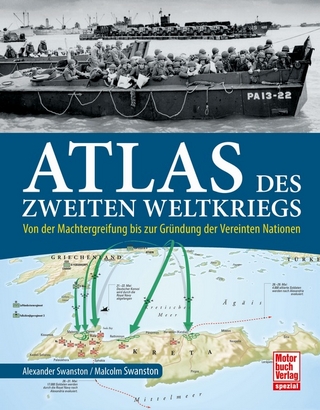
A Destroyer at War
The Fighting Life and Loss of HMS Havock from the Atlantic to the Mediterranean 1939-42
Seiten
2017
Frontline Books (Verlag)
978-1-5267-0900-4 (ISBN)
Frontline Books (Verlag)
978-1-5267-0900-4 (ISBN)
David Goodey traced over fifty of HMS Havock s crew during the 1980s, recording their recollections and first-hand testimony research which forms the backbone of this account
It was headline news on 8 April 1942: One of the Navy s most famous destroyers, a ship which survived bombs, torpedoes and full scale battles, has been wrecked . That destroyer was HMS Havock, described in another newspaper as Britain s No 2 Destroyer of this war second only in fame and glory to the Cossack. Havock had earned her reputation guarding the convoys across the Atlantic in 1939 and at Narvik in the abortive bid to stave off the German occupation of Norway in 1940/. Havock was then transferred to the Mediterranean, fighting at the Battle of Cape Spada in 1940 and in 1941 at the Battle of Matapan and in the evacuations of Greece and Crete. Havock s duties in the Med continued, escorting the convoys to the besieged island of Malta and the equally beleaguered garrison at Tobruk. Then in the Battle of Sirte in 1942 Havock was badly damaged and she limped into Malta for repairs. There she was heavy bombed and when Havock made a bid to reach Gibraltar, she was wrecked off Cape Bon. Her crew was captured and imprisoned in the infamous Laghouat internment camp.
The authors have tracked down fifty of the surviving crew and from interviews have been able to compile one of the most detailed, and certainly one of the most dramatic, histories of a destroyer during the Second World War. Destroyer at War tells the story of the battles and operations of a famous ship, and its sad destruction, through newspaper reports, official documents, and the words of the men who sailed and fought in HMS Havock as she earned an astonishing eleven battle honours in her brief but glorious career.
It was headline news on 8 April 1942: One of the Navy s most famous destroyers, a ship which survived bombs, torpedoes and full scale battles, has been wrecked . That destroyer was HMS Havock, described in another newspaper as Britain s No 2 Destroyer of this war second only in fame and glory to the Cossack. Havock had earned her reputation guarding the convoys across the Atlantic in 1939 and at Narvik in the abortive bid to stave off the German occupation of Norway in 1940/. Havock was then transferred to the Mediterranean, fighting at the Battle of Cape Spada in 1940 and in 1941 at the Battle of Matapan and in the evacuations of Greece and Crete. Havock s duties in the Med continued, escorting the convoys to the besieged island of Malta and the equally beleaguered garrison at Tobruk. Then in the Battle of Sirte in 1942 Havock was badly damaged and she limped into Malta for repairs. There she was heavy bombed and when Havock made a bid to reach Gibraltar, she was wrecked off Cape Bon. Her crew was captured and imprisoned in the infamous Laghouat internment camp.
The authors have tracked down fifty of the surviving crew and from interviews have been able to compile one of the most detailed, and certainly one of the most dramatic, histories of a destroyer during the Second World War. Destroyer at War tells the story of the battles and operations of a famous ship, and its sad destruction, through newspaper reports, official documents, and the words of the men who sailed and fought in HMS Havock as she earned an astonishing eleven battle honours in her brief but glorious career.
David Goodey s father, Albert William Goodey, joined the Royal Navy on 26 April 1938 at the age of 20. Having completed training at Chatham as a Rating in the engineering division he took his first commission in the new Hero-class destroyer HMS Havock on 29 September 1938. Albert remained part of Havoc s crew until 14 November 1941 just five months before she was lost. Richard Osborne is a retired lecturer in Pharmacology who was born in Portsmouth in 1948 and awarded a Ph.D in Neurochemistry by Imperial College in 1974. He has always had a keen interest in ships, joining the World Ship Society in 1962 and serving as its Chairman from 2000 to 2012. He has contributed to various magazines and has written or co-authored several books.
| Erscheinungsdatum | 31.01.2018 |
|---|---|
| Zusatzinfo | Central black and white plate section |
| Verlagsort | Barnsley |
| Sprache | englisch |
| Maße | 156 x 234 mm |
| Themenwelt | Natur / Technik ► Fahrzeuge / Flugzeuge / Schiffe ► Militärfahrzeuge / -flugzeuge / -schiffe |
| Geschichte ► Allgemeine Geschichte ► 1918 bis 1945 | |
| Geisteswissenschaften ► Geschichte ► Regional- / Ländergeschichte | |
| Geschichte ► Teilgebiete der Geschichte ► Militärgeschichte | |
| Sozialwissenschaften ► Politik / Verwaltung | |
| ISBN-10 | 1-5267-0900-7 / 1526709007 |
| ISBN-13 | 978-1-5267-0900-4 / 9781526709004 |
| Zustand | Neuware |
| Haben Sie eine Frage zum Produkt? |
Mehr entdecken
aus dem Bereich
aus dem Bereich
von der Machtergreifung bis zur Gründung der Vereinten Nationen
Buch | Softcover (2023)
Motorbuch Verlag
24,90 €


